Study on Novel Applications of the Maisotsenko Cycle
(Mサイクルの新規展開に関する研究)
Research on Open Cycle Heat Pump
(オープンサイクルヒートポンプの研究)
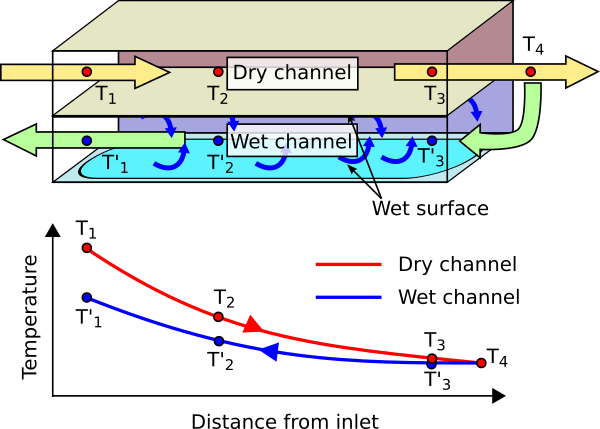
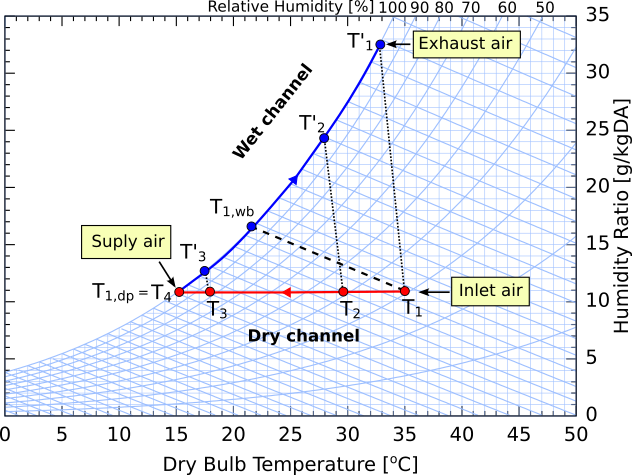
The air has a large capacity to hold water in the vapor phase and the air holding water vapor is called the wet air. In general atmosphere contains 1 to 3 % of water vapor; for instance, 1 kg of dry air can hold up to 20 g of water vapor at ambient temperature of 25 degree Celsius. This amount of water is equivalent to 50 kJ of thermal energy. Therefore, 1 kg of dry air has a capacity of holding 50 kJ as a latent heat. Moreover, the capacity is boosted with temperature rise; for example, at 40 degree Celsius, 1 kg of dry air can hold 50 g of water, which is equivalent to 125 kJ of thermal energy. The Maisotsenko Cycle (M-Cycle) is a thermodynamic concept to fully utilize the potential of wet air for heat and mass transfer processes. The M-Cycle is a proven technology and it is used for efficient evaporative coolers. One of the most major advantages of the M-Cycle is the enhancement of the cooling capacity by lowering the minimum temperature from the wet-bulb, which is the case of conventional evaporative cooling processes, to the dew point. It is a significant improvement from the viewpoint of energy savings because thermodynamic cycles, for both heat engines and heat pumps, improve the thermal efficiency and coefficient of performance with lower heat sink temperature, even if it is a few degrees of difference.
大気には1%〜3%の水蒸気が含まれます.例えば,25℃の空気1kgは,最大で約20gの水蒸気を含むことができます.水が蒸発する際や水蒸気が凝縮する際には熱の移動を伴うので,20gの水というのは約50kJの熱に相当します.空気が含むことができる水蒸気の量は,空気の温度が上昇するとともに急激に大きくなります.40℃の空気1kgは最大で約50gの水を含むことができ,熱量としては125kJに相当します.このように,空気は水蒸気という形で大きな熱を保持する能力があるのです.
Mサイクルは,空気が有するポテンシャルを最大限に活用する熱力学的な構想であり,提案者のProf. Dr. Valeriy Maisotsenkoの名前からMaisotsenko CycleまたはMサイクルと呼ばれています,水の蒸発を利用して空気を冷却する気化式冷却器は,入口空気の湿球温度が従来機器の理論的な冷却限界でした.しかし,Mサイクルを利用した気化式冷却器は,同じ条件の入口空気を理論的には露点まで冷却できます.
Mサイクルは,被冷却空気が流れる乾き流路と作動空気が水と直接接触する湿り流路から構成されます.被冷却空気は乾き流路端部で最も低い温度 (T4) となり,その一部の空気を抜き出して供給空気とします.残りの空気は流れの方向を反転し,作動空気として湿り流路を流れます.供給空気は,被冷却空気の7割程度の流量となります.
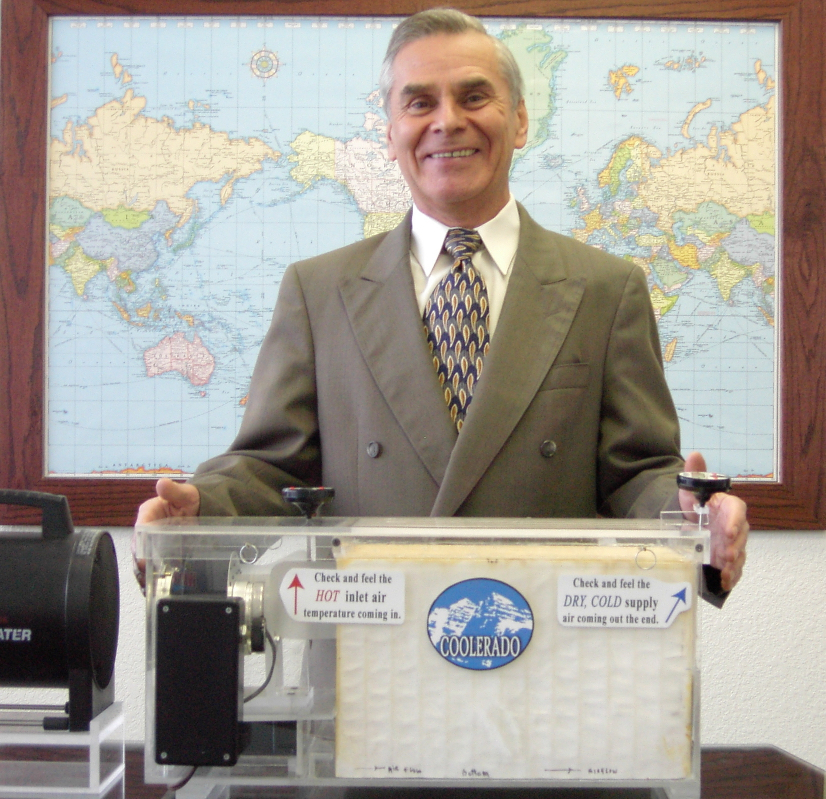
Mahmood, M.H., Sultan, M., Miyazaki, T., Koyama, S., Maisotsenko, V.S., Overview of the Maisotsenko cycle - A way towards dew point evaporative cooling, Renewable and Sustainable Energy Reviews 66 (2016) 537-555.
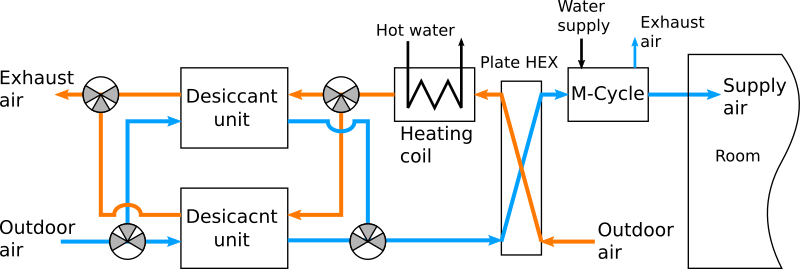
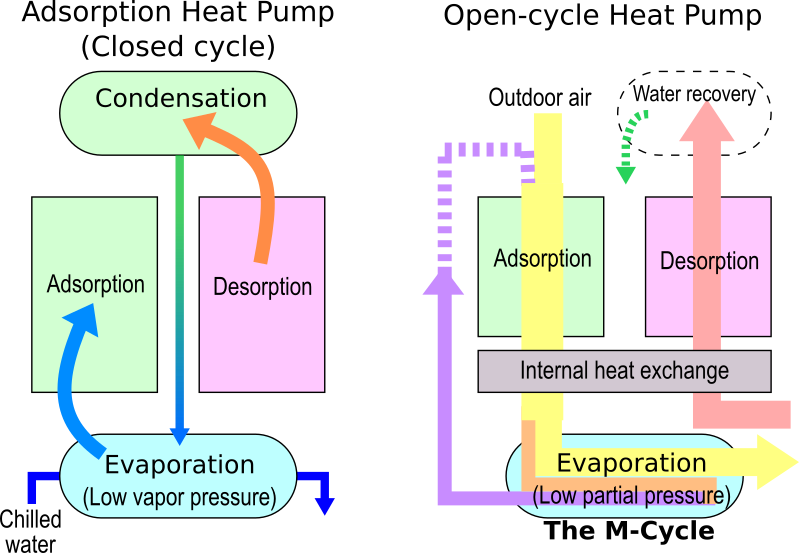
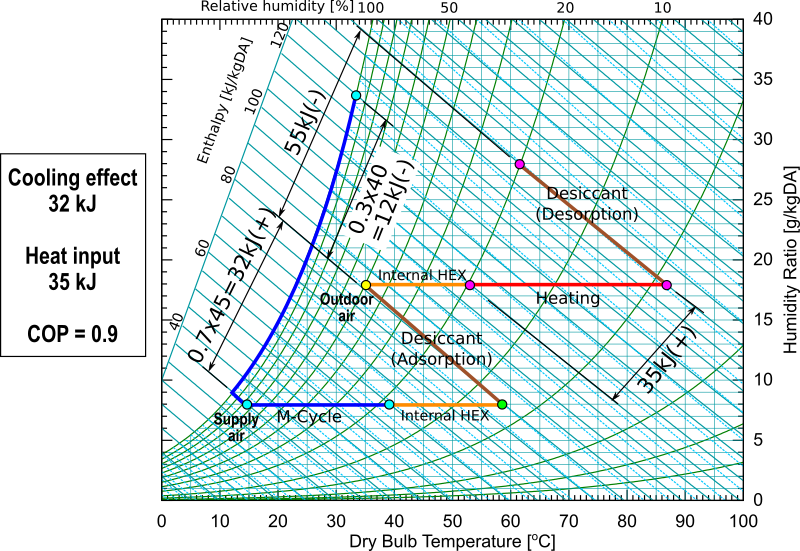
The dehumidification of air reduces the partial pressure of water vapor in the air. Then, the air can produce cooling effect at low temperature through the M-Cycle because the lower the humidify, the lower the dewpoint. The water adsorbed by the desiccant is released to the atmosphere at a high humidity during the regeneration of the desiccant. Therefore, M-Cycle and desiccant unit consit of open cycle heat pump . The principle of the open cycle heat pump is similar to adsorption heat pumps which use water as a refrigerant, but the open cycle heat pump has some advantages as follows:
空気中の水蒸気を吸着するデシカントユニットとMサイクル気化式冷却器を組み合わせたシステムは,水が冷媒となって空気を冷却するヒートポンプの構成になっています.デシカントユニットによる空気の除湿は,空気中に含まれる水蒸気の圧力(水蒸気分圧)を下げることと同等です.また,デシカントユニット再生後の空気は,多量の水蒸気を含みますので,水蒸気分圧が高い状態で環境に放出されています.したがって,低い圧力で水の蒸発による冷却を行い,その熱を大気に放出しているヒートポンプに等しいのです.
吸着材による水蒸気の吸着を利用するオープンサイクルヒートポンプは,オープン型の吸着式ヒートポンプとも言えますが,クローズ型の吸着式ヒートポンプと比較して以下のメリットがあります.
Miyazaki, T., Nikai, I., Akisawa, A., Simulation analysis of an open-cycle adsorption air conditioning system - Numeral modeling of a fixed bed dehumidification unit and the Maisotsenko cycle cooling unit, International Journal of Energy for a Clean Environment, 12 (2-4), 341-354 (2011).